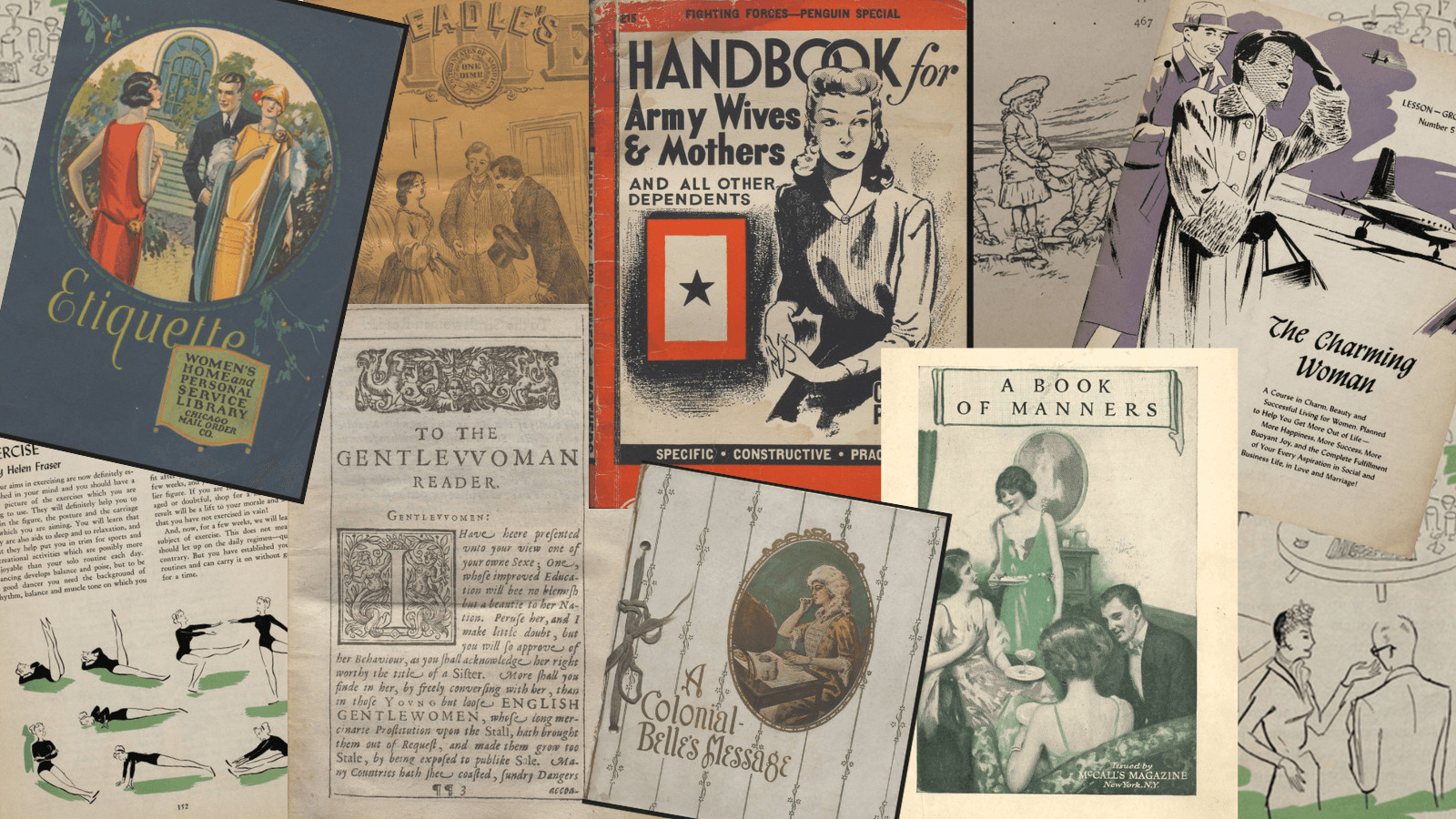|By Phil Virta, Senior Acquisitions Editor, Gale Primary Sources|
Gale’s Archives Unbound collection Etiquette and Advice, 1631-1969 is a fascinating digital archive of material from Winterthur Museum and Library in Delaware. A collection of 429 British and American etiquette books and rare print ephemera, it allows us to explore the question, “who gets to decide what behaviours are ‘good’ or ‘polite’?” The materials span from the seventeenth to twentieth century, offering tidbits on everything from table manners to travelling, conversation to courtship, home furnishing to hospitality. Author Dena Attar observes, in the face of fears about the “decay of modern manners and the instability of society, [etiquette] writers often described their books as necessary correctives for wider social problems.”1 This collection will therefore interest not only book historians, but also social historians, literary critics, cultural studies scholars, feminists, and other lifelong students of transatlantic history.
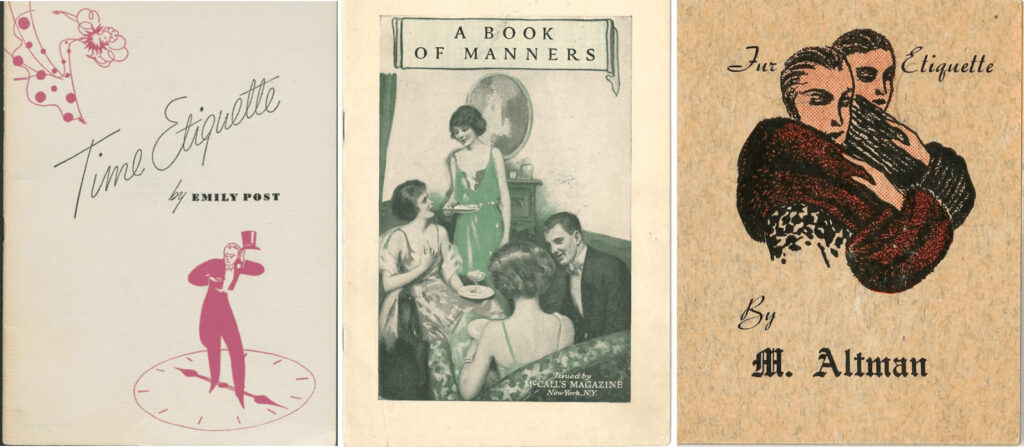
Centre: Magazine, McCall’s. A Book of Manners/ Issued by McCall’s Magazine. The McCall Co., 1922. Archives Unbound, https://link.gale.com/apps/doc/XHJBXB079237245/GDSC?u=virta&sid=bookmark-GDSC&xid=3a5c2dbd&pg=1
Right: Altman, M. Fur Etiquette/ by M. Altman. M. Rubinoff, 1937. Archives Unbound, https://link.gale.com/apps/doc/XHHRKY044044212/GDCS?u=webdemo&sid=bookmark-GDCS&xid=20bac3a3&pg=1
Some of the topics of study related to etiquette that can be studied in this Archives Unbound collection are shown in the image below:
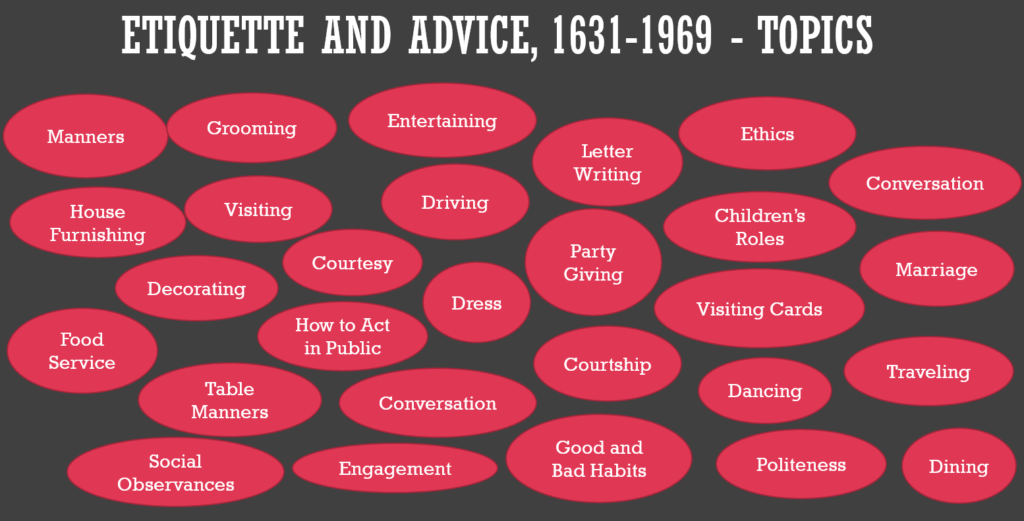
Etiquette is really about behaviours, choices and actions, so it will be interesting to discover what was being prescribed formally, socially, and by whom.
Etiquette in the Seventeenth Century
Let us journey back to the seventeenth century – 1631 to be precise, to examine the English Gentlewoman, Drawne out to the full Body. Interestingly, it was written by a man, Richard Brathwait, Esquire, an English poet and the author of Barnabee’s Journal, recording the drunken Barnabee’s pilgrimages through England in rhymed Latin. Aside from the English Gentlewoman, he also wrote the English Gentleman. Whereas gentlemen are advised about education and the management of public or private affairs, the English Gentlewoman promises advice and instruction on Apparell, Behaviour, Complement, Decencie, Estimation, Fancie, Gentilitie, and Honour.
This fascinating volume is seemingly more concerned with women’s appearance and obedience, as well as the relationship between their inner qualities and their outward appearance. While we don’t necessarily know what made Richard Brathwait an expert on etiquette and advice, particularly where women are concerned, his book does give us a glimpse of the habits of English society in the early seventeenth century. It would be interesting to discover what attitudes towards women described in the book are still with us today.
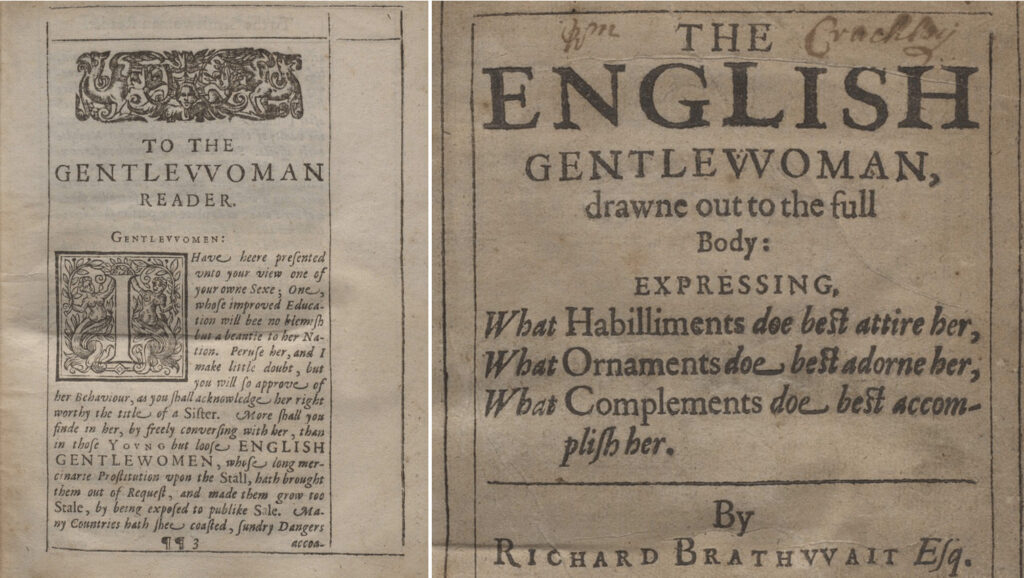
Left: https://link.gale.com/apps/doc/XDDGQS058466731/GDSC?u=virta&sid=bookmark-GDSC&xid=7b4eeab3&pg=8
Right: https://link.gale.com/apps/doc/XDDGQS058466731/GDSC?u=virta&sid=bookmark-GDSC&xid=7b4eeab3&pg=18
Etiquette in the Eighteenth Century – Present for an Apprentice (1742)
Present for an Apprentice, or, a Sure Guide to Gain Both Esteem and Estate: with Rules for His Conduct to His Master, and in the World is a guide for young English men starting out on their lives and careers. The author of this work is given as the Late Lord Mayor of London and the editor’s dedication is to Sir John Barnard, one-time Lord Mayor of London. It is believed to have been written by Sir John Barnard, with a first publication in 1740 and many subsequent printings in the years thereafter. The work is addressed to the writer’s son. In the introduction, the author writes,
“Recollecting, therefore, that life is a scene of care, and prudence generally the child of experience and calamity, I have thought it advisable to make you the heir of what knowledge I am possessed of, as well as my estate; that you may be guarded against all the snares to which youth is obnoxious; and that you may be as well provided with advice in all exigencies, as when under my wing; or as if you had already suffered all I would teach you to avoid.”
View source
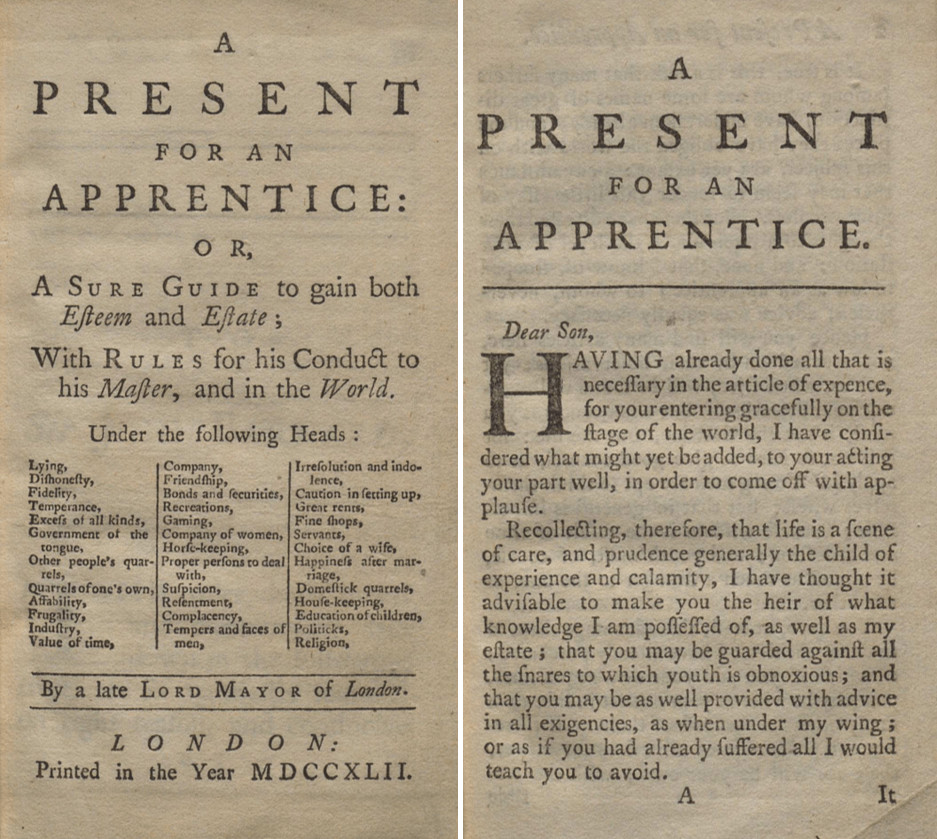
The passages in the work offer advice on many aspects of how a young man should comport himself socially. There are admonitions against Lying and Dishonesty, and against Offending Women:
“But it is more especially dangerous to make free with the persons or characters of women: for they are naturally prone to rage; and, through the very frailty of their natures, seldom fail to avenge, what braver minds either overlook or forgive.”
View source
There is quite a bit to dissect in that one sentence, and much that is considered offensive in contemporary society, but it would seem the author may have been on the wrong side of some arguments with women in his time!
Other passages deal with Frugality; Industry; and the Value of Time; there is something on keeping company with Men of Sense; there is advice on Recreations such as Cheap Pleasures, Musick, Gaming, the Company of Ladies, Masquerades, and Horse Keeping. There is counsel against Suspicion and Rash Resentments. There are guidelines for employing Servants as well as about Familiarity with them, although it is also nice to see “Servants are not to be oppressed, But used with lenity”. There are some number of pages on Choice of a Wife, Courtship, Complaisance after Marriage, and Education of Children. At the end are Politicks and Religion, and the author’s counsel for Politicks is:
“Despise flattery on one side, disdain on the other; and let the venal of all ranks know, that your traffick is not in infamy, nor your gains the wages of corruption.”
View source
His instruction concerning Religion:
“I would have you both awfully reverence, and devoutly practice: but not as the hypocrites do, as a fort of commutation with the world, for living like a cannibal, and preying upon your fellow-creatures.”
View source
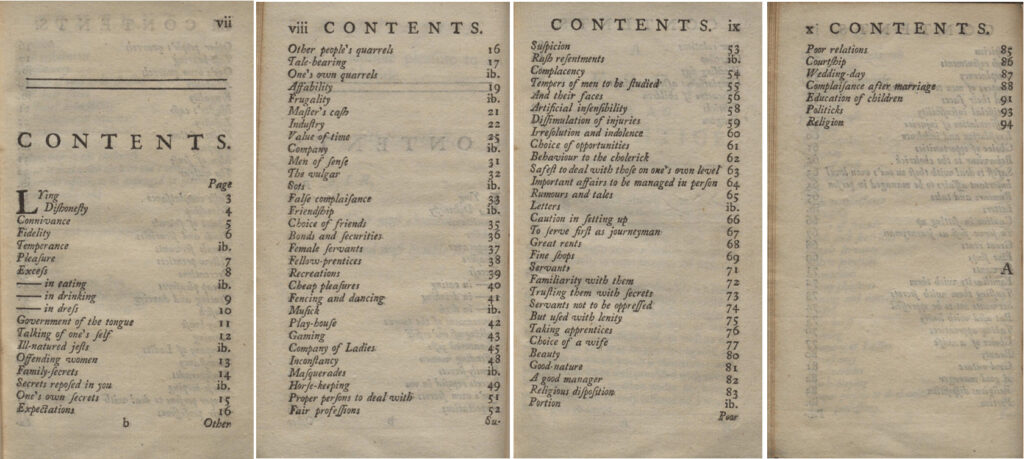
Etiquette in the Early Nineteenth Century – Colonial Belle’s Message (My Lady’s Toilette Table)
Let us now review a book from the antebellum American South, Colonial Belle’s Message (My Lady’s Toilette Table). The description provided indicates, “The Original of This Book Is a Century-Old Heirloom in a Cultured Southern Family. The Following Pages Reproduce Faithfully the Priceless Volume, as Hand Written and Illustrated in Water Colors/ by the Gifted Authoress Catharine Shepherd, of Virginia.” That would mean the original work was created in the early nineteenth century. The original book, and indeed this reproduction, had beautiful illustrations with small covers or flaps that could be lifted to reveal a hidden word that was described in the text. The book is quite colourful, with delightful illustrations and text written in a charming hand. Each page offers a piece of advice for ladies about good culture, comportment, and etiquette. Overall, it shows what was considered right and proper for refined American Southern ladies in the early 1800s.
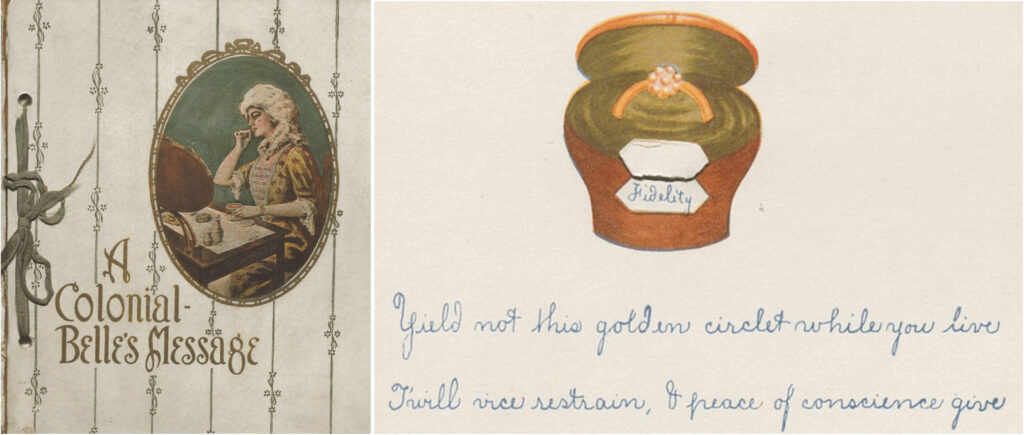
Left: https://link.gale.com/apps/doc/XGAIWQ095098147/GDSC?u=virta&sid=bookmark-GDSC&xid=f6ab89e5&pg=1 Right: https://link.gale.com/apps/doc/XGAIWQ095098147/GDSC?u=virta&sid=bookmark-GDSC&xid=f6ab89e5&pg=51
Polite Society in 1864 – Beadle’s Dime Books
Beadle’s Dime Books were quite popular in 1860s America, offering etiquette books for young people; guides for the family such as cook books, a housewife’s manual, and the family physician; books on gaming and pastimes; and books of dialogues for school exhibitions and home entertainment. The book shown below is Beadle’s Dime Book of Etiquette: a Practical Guide to Good Breeding, and Complete Directory to the Observances of Society. The introduction is descriptive of what one will find inside:
“Has the moment arrived when you are called upon to cast aside your youthful associations and youthful irresponsibilities to take your place in society as a man or woman? It is a most important moment—one which deserves the consideration of a thoughtful study; for, upon a proper knowledge of what belongs to true manhood, true womanhood, does much of your after-life success depend. If you are ignorant of the laws of politeness, of the rules and observances of true sociality, of the means necessary to render yourself an agreeable companion and a useful member of the social circle, you begin life at immense disadvantage, and will never cease to regret that ignorance. It is such an easy matter to become familiar with the usages and proprieties of social life that ignorance is inexcusable; and when we see men of sense and sagacity behaving, in an assembly, at a party, at the dinner-table, at the card-table, like half-tutored savages—rude, awkward, uncivil, a source of annoyance to their friends, we feel a degree of indignation rather than of pity, since it is so easy to learn how to behave, that there really is no good excuse for boorishness and awkward deportment.”
View source
Dime books were meant to be instructive guides for the everyman and everywoman of America. Their price made them accessible to many, but during a time when formal education was not available to all, only certain members of society would benefit from them.
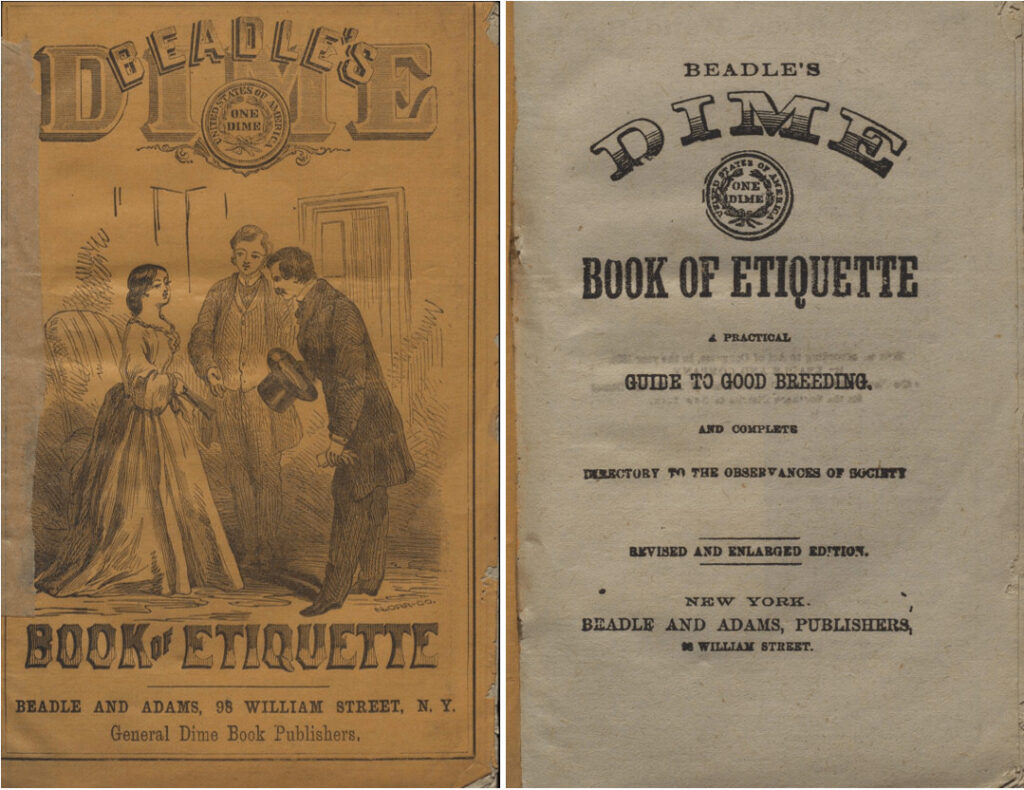
Polite Society in the Late Nineteenth Century
Many volumes were written on the rules of polite society, essentially how to be socially superior and set the standard for others. Sometimes, “polite society,” with all its rules, is thrust upon us as a duty. When her elder brother, Grover Cleveland, became the 22nd President of the United States in March 1885, Rose Cleveland assumed the duties of First Lady and lived in the White House for fifteen months. She stood by her brother during his inauguration and was his hostess during his bachelor years in the White House. Let it not be assumed that Rose was not equal to the task; according to the White House Historical Association, Rose Cleveland was “a woman of unusual gifts, of large and varied information, of vigorous views and strong convictions.” An author herself, Rose wrote the introduction for the etiquette book Our Society published in 1893:
“Like all good books, this book is suggestive rather than exhaustive. The best books finish nothing. The best readers are those who read to the last page, but reach “The End” only in their own cogitations. We all have need to think much upon the themes suggested in the following pages. Of such books there are none too many. Every page, wherever found, which serves to make clearer the mutualities of life, is a golden page. Every line which goes to emphasize that pregnant, all-significant truth that “No man liveth to himself and no man dieth to himself” contributes pressure to the upward leverage of the human race. Everything which tends to better our morals or improve our deportment in the home or social circle, conspires toward a culture which fulfills the purposes of living and achieves the will of God towards man.”
– ROSE E. CLEVELAND
View source
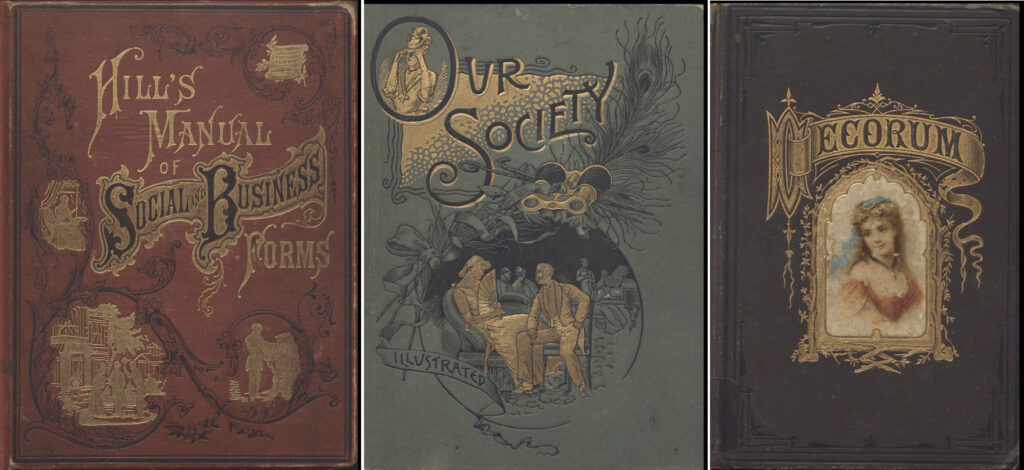
Centre: Ives, Alice E., et al. Our Society: a Complete Treatise of the Usages That Govern the Most Refined Homes and Social Circles. Our Moral, Social, Physical and Business Culture/ by Alice E. Ives … [et al.]. Darling Publishing Company, 1893. Archives Unbound, https://link.gale.com/apps/doc/XEKEFW716266652/GDSC?u=virta&sid=bookmark-GDSC&xid=5fbc526e&pg=1
Right: Decorum: a Practical Treatise on Etiquette and Dress of the Best American Society. Union Publishing House, 1880. Archives Unbound, https://link.gale.com/apps/doc/XEFKIA818866975/GDSC?u=virta&sid=bookmark-GDSC&xid=9c876ada&pg=1
Our Society provided advice on proper form and etiquette in social situations. There are chapters on how to act in public places, proper salutations, how to comport oneself while riding and driving, the art of conversation, how to make one’s home beautiful, understanding the rules of family government and courtesies in the family. It also provides guidance on how to keep your daughters near you, while also admonishing you to be patient with the boys. In essence, it seems to indicate watching over the girls, while allowing the boys a bit more free rein; not exactly a model for a society of equals.
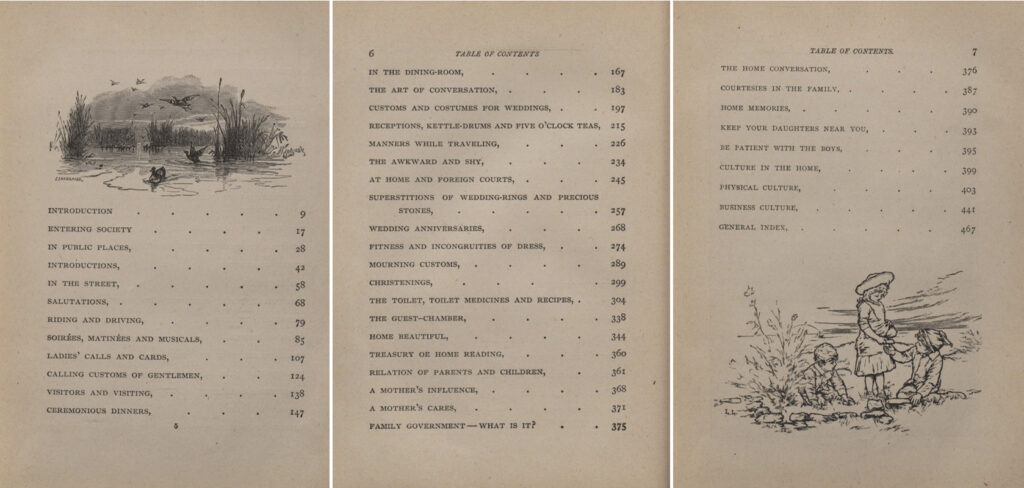
Etiquette in the Twentieth Century – Emily Post
One person who helped transition etiquette into the twentieth century was Emily Post. The Emily Post Institute gives us this brief account of what she witnessed during her long life:
“Emily Post was alive from 1872 – 1960. Her life started in the age of the horse and buggy, watched the first roadways across the continental United States get built, saw America through both the start and end of the prohibition of alcohol, the great depression, and ended with peace, love and microwave ovens.”
View source
Emily Post was a novelist, author, and a renowned socialite whose books on etiquette influenced generations of people interested in good manners and refined social culture. In her own words, “Whenever two people’s lives come together and affect one another. You have etiquette. Etiquette is not some rigid code of manners; it’s simply how people’s lives touch one another.”
One of Emily Post’s most widely distributed books was Etiquette. First published in 1922, it quickly rose to the top of the nonfiction bestseller list. Interestingly, Etiquette was the second most likely book to be stolen from the library, right after the Bible; a breach of etiquette if ever there were one! On the topic of etiquette, Emily Post defined it:
“One is apt to think of Etiquette as being of no more real service to the average citizen than a top hat—something that is of importance to none but brides or diplomats or the newly-rich or persons lately elected to political office. As a matter of fact, there is not a single thing that we do, or say, or choose, or use, or even think, that does not follow (or break) one of the exactions of taste, or tact, or ethics, or good manners, or etiquette—call it what you will. I wish that those whose minds are focused on precise obedience to every precept would ask themselves instead, “What is the purpose of this rule? Does it help to make life pleasanter? Does it make the social machinery run more smoothly? Does it add to beauty? Is it essential to the code of good taste or to ethics? If it serves any of these purposes, it is a rule to be cherished; but if it serves no essential purpose, it is certainly not worth taking very seriously.”
View source
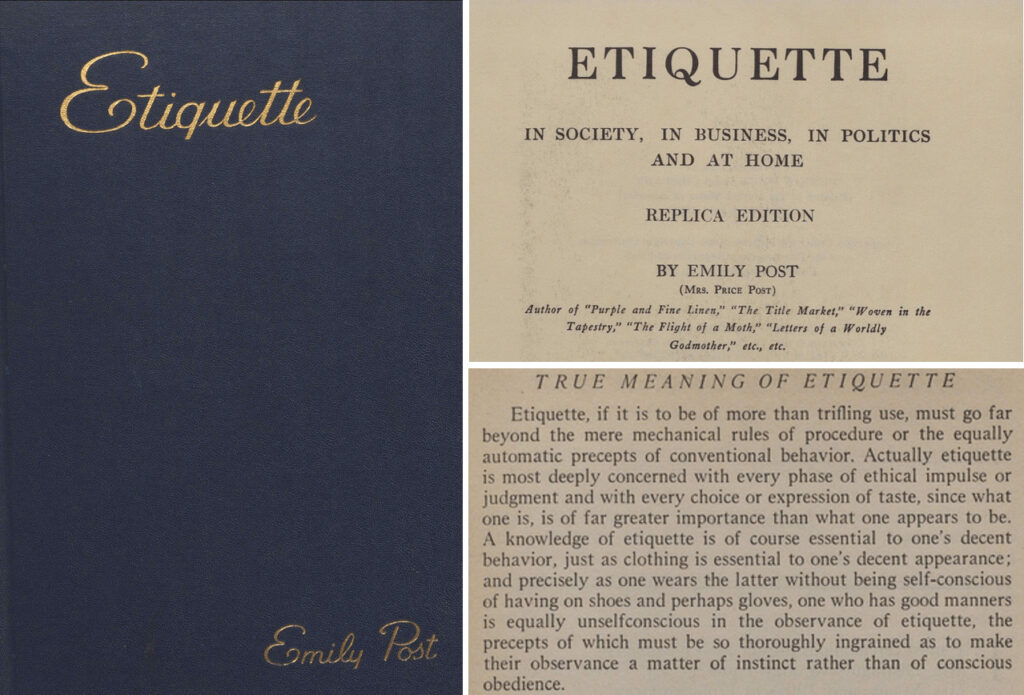
Etiquette During War Time
When wars occur, societies are disrupted; war and conflict is terrible, but also a vehicle for social change. Printed in 1944, the Handbook for Army Wives & Mothers and All Other Dependents is a “Specific, Constructive, and Practical” guide for women whose soldier is away at war. The introduction is quite descriptive about the decorum and social mores a woman should exhibit:
“Here is a book that tells you what you can do to help your soldier and your Army. As far as your man in the Army is concerned, you want to be sure to do those things which will help make him a better and a happier soldier; this book tells how to go about that. In helping him, you will also be helping the Army as a whole; and in the following pages you will find many practical suggestions for additional things you can do to help the Army win the War. The Handbook for Army Wives and Mothers discusses your personal war time problems and shows their relationship to the job of winning the war. The book talks concretely about such subjects as the workings of the Selective Service Law; whether you should stay at home or follow your man to his Army camp; how the Army feeds and shelters your soldier; Army etiquette; the Army wife who stays home; children; civilian and military jobs for women volunteers; paid jobs; allotments and dependency allowances; other government and private benefits; keeping in touch with your soldier; etc.”
View source
It would be interesting to compare these social instructions to army wives and mothers to the Basic Field Manual and Soldier’s Handbook distributed to U.S. Army soldiers to compare and contrast how they were instructed to comport themselves.
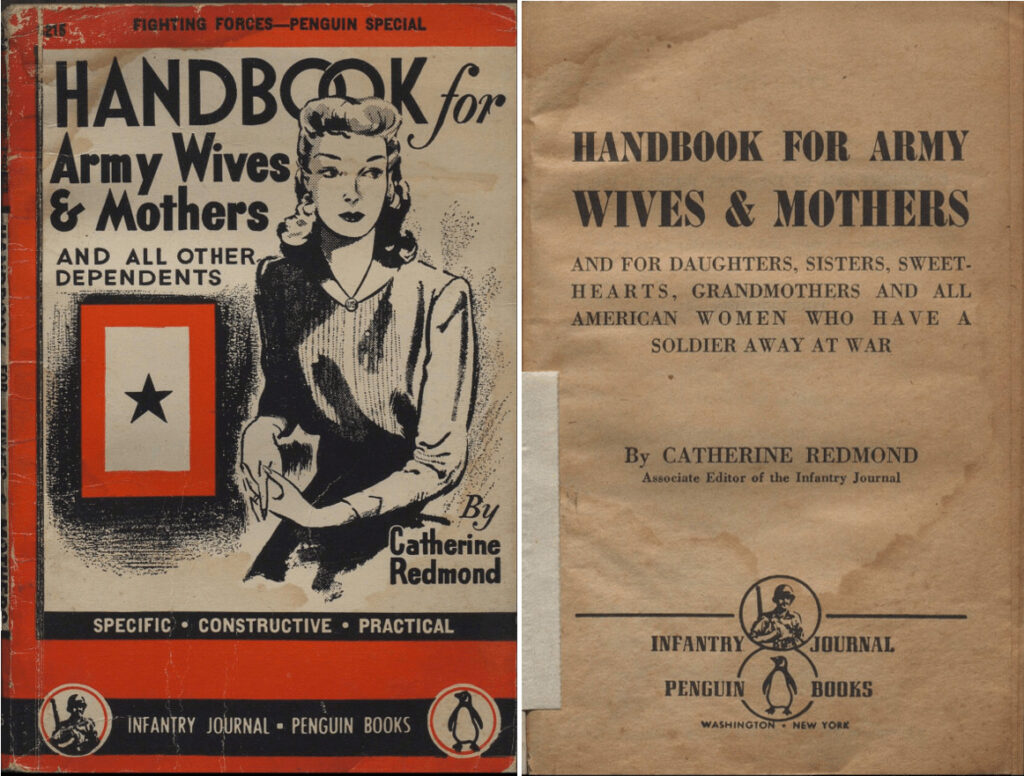
Lessons in Etiquette from 1951
The Charming Woman was a series of publications written by Helen Fraser that provided a guide for women of the 1950s to achieve their personal and relationship goals. The cover of each lesson promised:
“A course in charm, beauty and successful living for women. Planned to help you get more out of life more happiness, more success, more buoyant joy, and the compete fulfillment of your every aspiration in social and business life, in love and marriage!”
View source
The social mores of the era are laid-out in a day-to-day regimen that helped women transform themselves into the “Charming Woman”. The issues feature series on “Skin Care” by Helena Rubinstein, “Exercise” by Helen Fraser, “Care of the Nails” by Charles Revson, “Care of the Hair” by Clara Ogilvie, “Diet” by Frankie Van, “How to Wear Hats” by Mr. John, and “Poise and Personality” by Lily Pons. Each issue is about 32 pages in length. Aside from instructions and advice, the issues are full of useful photos and wonderful two-colour illustrations of social situations and helpful information.
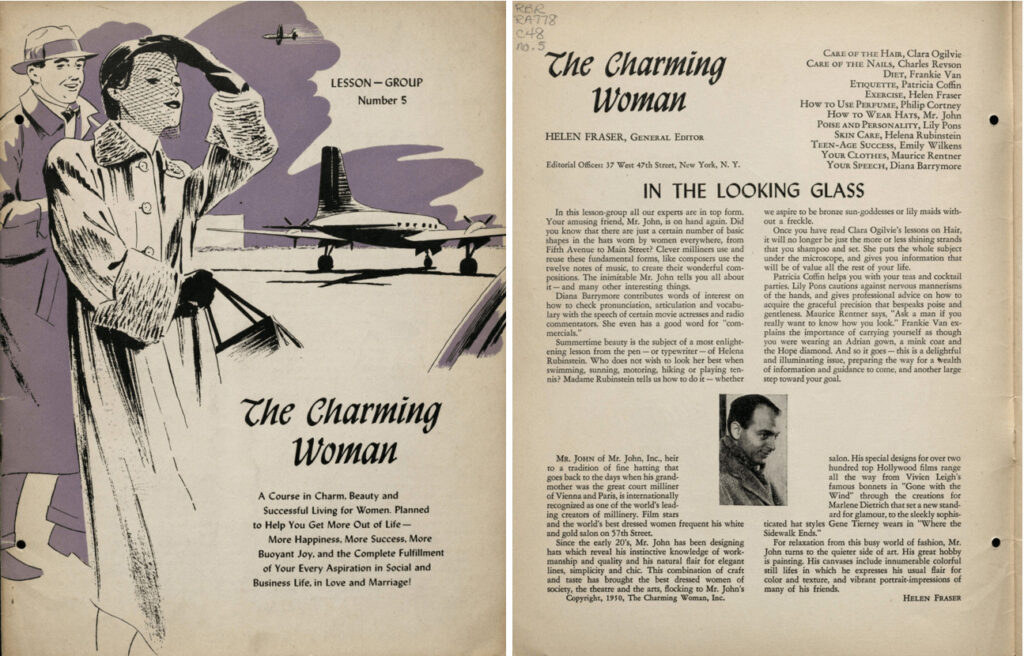
Becoming The Charming Woman required hard work and dedication; it was not something that happened overnight, but rather over the course of many days, all nicely laid out in the guide. The publication provided ladies with chapters on etiquette, proper dress, how to serve, self-improvement, and care of the body.
Some of the illustrations are perhaps the most fun and interesting, providing glimpses of polite society in the 1950’s and what was expected of a refined lady. Of course, this publication was, perhaps inadvertently, directed at only a certain segment of society. Post-World War II America saw many social advances for women, but mainly white women. The 1950’s was a time of great social conflict in America, as indicated by the budding civil rights movement and anti-communist sentiment. There was equality and freedom for some, but not for all.
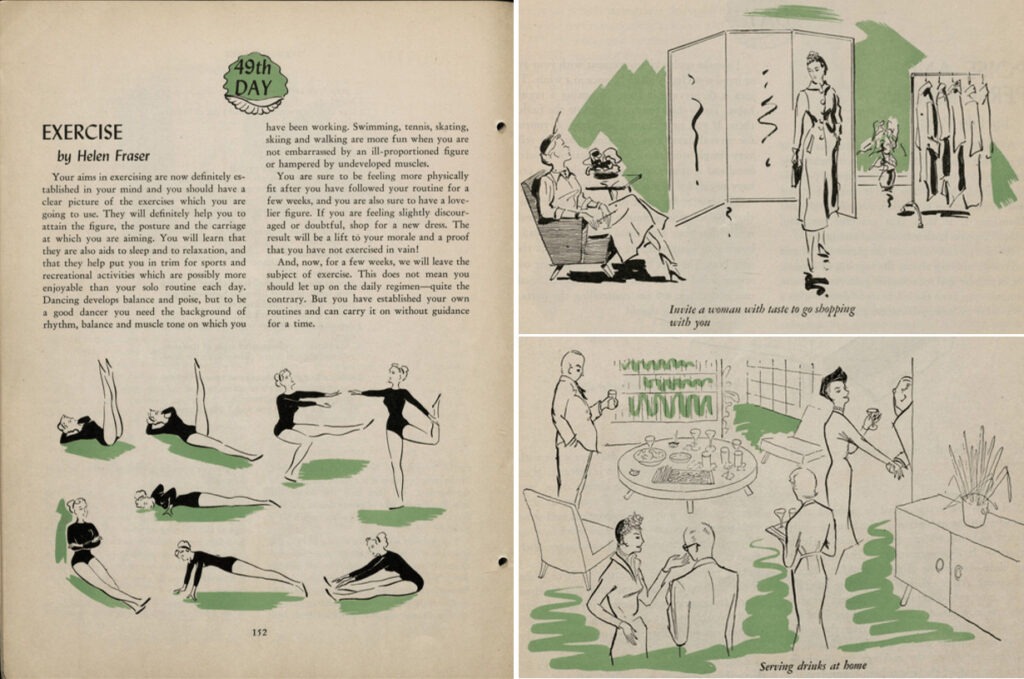
Windows on Social History
The books in Etiquette and Advice, 1631-1969 provide us with windows on society and social history. In their pages we can visit the past, mingling with both the tasteful and the vulgar. We can learn useful lessons about how to comport ourselves, and what one should not do in certain situations in order to avoid embarrassment. The customs and culture described in the books help us better understand how society functioned at various times in the past and allow us to consider what we have retained today, as well as what has been discarded. A thorough reading of the books in Etiquette and Advice will indicate what members of society these works were written for, and by their absence, those with whom the works were not concerned. Enjoy your journey through this wonderful collection and don’t forget to mind your manners!
![Top Left: Rise and Shine/ [Dorothea Cole]. National Dairy Council, 1941. Top right: Hesburgh, Theodore M. Letters to Service Women/ by Reverend Father Theodore M. Hesburgh; Sketches by a WAVE, Colette M. Kelly. Holy Cross College, 1943. Bottom Left: Etiquette. Chicago Mail Order Company, 1925. Archives Unbound, Bottom Right: How to Woo: When and Whom. Dick and Fitzgerald, 1870. Archives Unbound](https://review.gale.com/wp-content/uploads/2022/07/How-to-Woo-and-others-combined.jpg)
If you enjoyed reading about etiquette and advice manuals through the ages, you might like:
- “When is a Woman…?” Exploring Cultural Expectations of Women Advocated in Historical Newspapers
- Elbows off the table
- Fashion and the Eighteenth-Century Public Sphere: from Tatler to Twitter
- From coupons to cocktail dresses: tracking changes to women’s wartime fashion using the Picture Post
- Exploring Early Modern Erotica and Social History in L’Enfer de la Bibliothèque nationale de France
If you’d like to read more about Archives Unbound, and the collections within this series, try:

